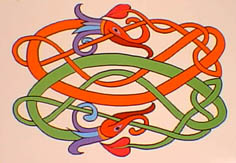Who Are The Celts?
There are generally six Celtic peoples recognized in the world
today. They divide into two groups, the Brythonic (or British) Celts, and the Gaelic
Celts. The Brythonic Celts are the Welsh, Cornish and Bretons; the Gaels are the Irish,
Scots and Manx (inhabitants of the Isle of Man). Some people recognize a seventh Celtic
nation in the region of Galicia in Spain (their Celtic language died out a thousand years
ago, and so the Celtic links are more tenuous).
Because of the great potato famine in Ireland in the
19th century,
so many Irish migrated to the U.S. that they are by far the largest contingent of Celts in
this country. Many people here mistakenly believe that Celtic means the same as Irish
(this, of course, does not go down well with the rest of the Celts). The Scots form the
next largest group of Celts in the U.S., with the Welsh trailing in numbers. How many
Celts are there here? It's hard to say exactly, because of the number of part-Celtic
Americans, but it is at least a quarter of the population.
The Celts are a musical, artistic people, with a love of words.
They also love a good time, and hold many festivals around the country each year. On March
17, when the Irish pull out the stops to celebrate their day, perhaps the United States
becomes the seventh Celtic country. We are surely the richer because of the Celts'
presence here.
The history of the Celtic peoples goes back some thousands of
years; at one time all of Europe was Celtic. The earliest European Celtic culture was in
Hallstadt, Austria, and this was followed by the La Tene Celts in Switzerland. Over two
thousand years ago England was ruled entirely by Celts; eventually the Romans, Jutes,
Angles and Saxons came and pushed the Celts to the north and west. One of the great Celtic
events of history was the fifth-century battle between King Arthur and his Celtic army
against the dark pagan hordes in England (as the Celts termed the non-Celtic peoples); the
Celts considered King Arthur's loss in that battle to be the death of civilization. King
Arthur himself remains an important figure in Celtic legend; the original story is now
much embroidered with medieval knights and traditions.
 The ancient Celtic art was full of interlacing patterns, spirals,
animal forms, and color. The early Celts displayed their art especially in metal: jewelry,
weapons (they were fierce warriors), figurines and pots are some of the many artifacts
that have come to light.
The ancient Celtic art was full of interlacing patterns, spirals,
animal forms, and color. The early Celts displayed their art especially in metal: jewelry,
weapons (they were fierce warriors), figurines and pots are some of the many artifacts
that have come to light.
When Christianity came to the Celtic lands of Britain and Ireland,
the monks of the seventh century adapted the ancient Celtic art forms to the new religion;
the Celtic cross and tree-of-life designs, for example, came from this marriage. Writing
also came to the Celts for the first time; the most famous manuscript by the monks is the
beautiful Book of Kells, on display in the library of Trinity College in Dublin.
(The historical Brian Boru harp is also on display in the same room.)
The harp has been the national instrument of all the Celtic
peoples since the dawn of their history. In ancient times this would have been a primitive
instrument, and the modern triangular harp did not appear in recognizable form in stone
carvings until about the seventh century. The Celts have other instruments now, of course:
bagpipes, whistles, flutes and drums among others.
Modern Celtic peoples have evolved symbols for themselves, and in
North America people of Celtic descent often wear these symbols to show which group they
are from. For instance, the commonest Irish symbol is the three-leaved shamrock, although
the harp is often used as well. The Scottish symbol is a thistle, along with wearing of
tartans. The Welsh flag is a red dragon on a green-and-white background; the Welsh
consider the red dragon as their most Welsh symbol, but along with the dragon they
recognize the leek and the daffodil.
The Celts are the most hospitable people you could hope to find
anywhere. Are you of Celtic blood? Yes? No? It doesn't matter! Welcome, more welcomes and
a hundred thousand welcomes! Have something to eat and drink, and we'll talk all night.
Perhaps there will be music, singing and dancing. Whatever, have a good time and please
come again.
We at The Harp and Dragon hope you will enjoy your stay
with us as you peruse our many Celtic pages. You are very welcome indeed, and, of course,
please do come again. Our welcome mat is always out.
Anne Habermehl, B.Sc.
Return to Home Page
There are over a hundred pages on this web site; click on the Return
to Home Page link
to see an outline of this entire site.
 The ancient Celtic art was full of interlacing patterns, spirals,
animal forms, and color. The early Celts displayed their art especially in metal: jewelry,
weapons (they were fierce warriors), figurines and pots are some of the many artifacts
that have come to light.
The ancient Celtic art was full of interlacing patterns, spirals,
animal forms, and color. The early Celts displayed their art especially in metal: jewelry,
weapons (they were fierce warriors), figurines and pots are some of the many artifacts
that have come to light.